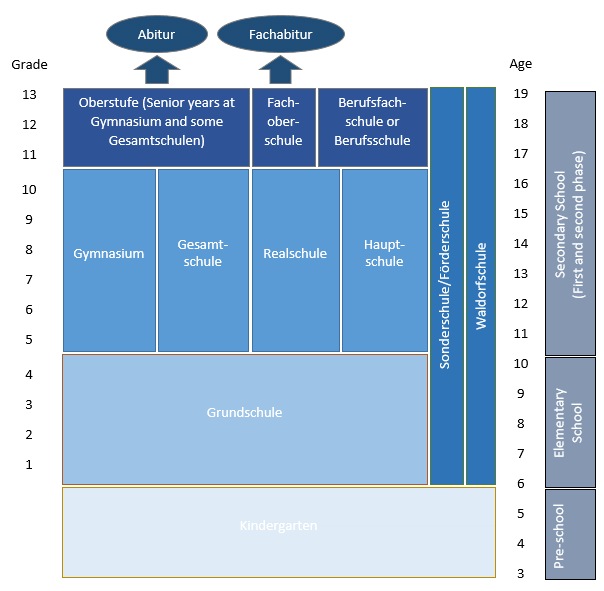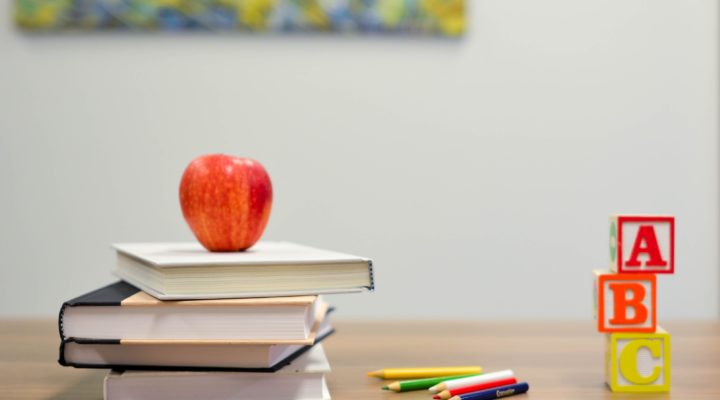The German education system is quite different from the wide-spread British and American education system or even others in the world. It starts with optional pre-school education (1- to 6-year-olds) and then continues with the compulsory public school system of primary (6- to 10-year-olds) and secondary school (10-year-olds onwards, with three different types of school depending on level of education). Afterwards, students may choose to go further and attend university, which offers higher education at various kinds of institutions.
1-Daycare in Germany
Although it is not compulsory for them to attend, by law all children aged between one and five years are entitled to a place at a Kita. Despite efforts to increase availability, however, there are still not enough places to keep up with demand. It is worth registering your child as soon as possible to secure a place. Next to that, there is also the concept of a Tagesmutter: A Tagesmutter is a childminder and often runs her childcare out of her own home which is specifically organised to provide care for a small group of children. A Tagesmutter tends to take on just a small number of children at a time and so is often able to offer smaller group sizes than many Kitas. This makes them popular for parents who are looking for childcare for their babies around one year old and younger.
2-Schools in Germany
Germany’s education system offers top-quality schooling. Nevertheless, it can vary significantly from one Bundesland (state) to the next, making it quite challenging to choose among the best schools and higher education options for your children. While there are public school districts for elementary school children, parents can later choose among a number of schools in Germany for their older kids as there are no district limitations for secondary education.
At the age of 6, children attend primary school for four years. In their fourth year the decision is made on how to continue their education. The secondary school system is divided into: Hauptschule, Realschule, Gymnasium and Gesamtschule.
1.1 Primary school
Children start primary school in the autumn term the year a child turns six years old. They then stay there until age 10. On the first day at Grundschule, it is tradition for a child to bring a Schultüte, which is a large decorative conical parcel filled with candy and little presents, and the older school children may put on a performance for new students and their families.
There are usually four grades or years (1–4) in German primary education, although in some regions primary school continues until year 6. Children usually go to the primary school nearest their home.
Primary school lessons include literacy, mathematics, science, a foreign language, religion, and computer skills. However, details of the curriculum are decided by the states so will vary across Germany.
1.2 Hauptschule
The Hauptschule (grades 5-9) teaches the same subjects as the Realschule and Gymnasium, but at a slower pace and with some vocational-oriented courses.
1.3 Realschule
The Realschule (grades 5-10 in most states) leads to part-time vocational schools and higher vocational schools. It is possible for students with high academic achievement at the Realschule to switch to a Gymnasium on graduation.
1.4 Gymnasium
The Gymnasium leads to a diploma called the Abitur and prepares students for university study or for a dual academic and vocational credential. Curricula differ from school to school, but generally include German, mathematics, physics, chemistry, biology, geography, art (as well as crafts and design), music, history, philosophy, social studies, and several foreign languages. In recent years many States have changed the curriculum so students can get the “Abi” at the end of the 12th grade.
1.5 Gesamtschule
The Gesamtschule, or comprehensive school, is only found in some of the states. It takes the place of both the Hauptschule and Realschule. It enrolls students of all ability levels in the 5th through the 10th grades. Students who satisfactorily complete the Gesamtschule through the 9th grade receive the Hauptschule certificate, while those who satisfactorily complete schooling through the 10th grade receive the Realschule certificate.

3- Private Schools
There are a number of different types of private schools in Germany. These schools usually charge tuition and may offer varied courses leading to the German Abitur as well as other diplomas and certificates at the conclusion of studies. Private schools might offer a different style or approach to education at public schools. Some examples:
3.1 Religious schools
Religious or denominational schools in Germany are founded on a specific faith such as Protestantism, Catholicism or Judaism. Attending a religious school doesn’t necessarily mean you need to practice that religion, but you will be expected to observe and respect their customs.
3.2 Freie Waldorfschulen (Rudolf Steiner schools)
Following the educational philosophy of Rudolf Steiner, Freie Waldorfschulen have a long history in Germany, with the first being opened in Stuttgart in 1919. Steiner schools have a holistic approach to education that emphasises creativity and imagination to develop pupils’ intellectual, artistic and practical skills.
3.3 Montessori schools
The Montessori educational approach, based on the work of Italian educator Maria Montessori, relies on the concept that children are inherently curious and resourceful. By placing them in a supportive learning environment, the method encourages the development of children’s natural abilities through discovery and play.
3.4 Free alternative schools (Freie Alternativschulen)
Partially based on concepts like the Montessori approach, free alternative schools encourage individual responsibility, varied lesson formats and mixed-age classes.
3.5 Jenaplan schools
Jenaplan schools are founded on the concepts of Peter Petersen and promote cooperation and communal living, in particular, shared responsibilities for children, teachers and parents. The Jenaplan emphasises the uniqueness of each human being and encourages learning via teaching, celebration, discussion and play.
4- International Schools
International schools in Germany are mostly privately-run institutions; although there are a few that are part of the public system. They are a big draw for foreign families that want their kids to be schooled in another language – usually English. This can help students feel more comfortable as they transition into life in a new country.
These are full-day schools with students from different nationalities and countries represented. They offer a full range of educational subjects and extracurricular activities. They’re perfect for students who are already halfway through their curriculum in their own countries.
If you need more information or want us to help you through the “jungle” of the German education system, please have a look here or send us a message. We have been helping international families to find a Kita or school for more than 10 years and know the educational offer like the back of our hand.


